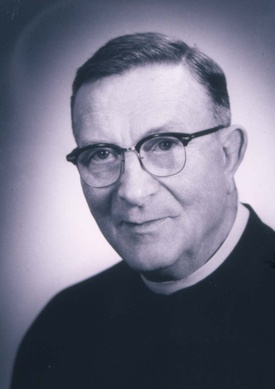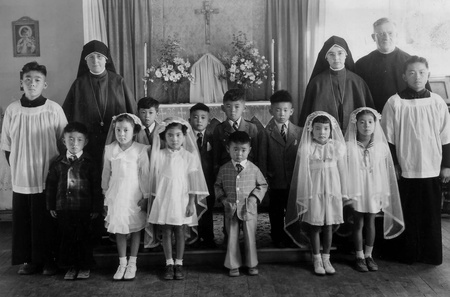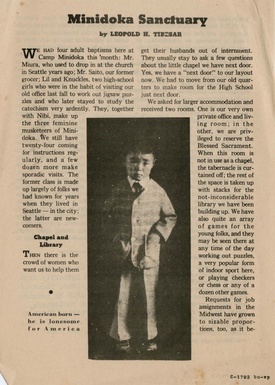Perhaps some of the best-known defenders of Japanese Americans during World War II were the religious leaders of Seattle. Leaders like Baptist minister Emery Andrews and Buddhist minister Gladys Sunya Pratt supported the Japanese American community in the face of allegations of treason, and worked with the community throughout the incarceration. One such individual was Father Leopold Tibesar, a Catholic priest and Maryknoll missionary. As historians like Anne Blankenship have written about Father Tibesar’s work with the Seattle community, Tibesar’s long career in Japan, Manchuria, Los Angeles, and Seattle tell the fascinating story of Tibesar’s transnational career.

Leopold Henry Tibesar was born in Quincy, Illinois on August 27, 1898 to Nicholas Tibesar, a professor of physical sciences from Luxembourg, and Christina Tibesar, a German immigrant. The oldest son, Leopold spent of his youth in Quincy, attending school at St. Francis Catholic school. Upon graduating from high school at age 18, Tibesar decided to follow his calling and enter the priesthood. He enrolled at Kenrick Seminary in St. Louis, Missouri, in 1916, and after three years of study went to Catholic University in Washington, D.C. in 1919 to complete his education in theology. In June 1921, Tibesar was ordained as a priest, and began work at the Maryknoll Seminary in Ossining, New York. Tibesar taught at Maryknoll Seminary for six years, and from 1923 to 1926 he was the director of the Maryknoll Seminary.
Father Tibesar would spend much of his prewar career working in East Asia. In 1926, Maryknoll sent Tibesar to Tokyo, Japan to teach at the Junior Seminary there for a year and learn Japanese. He then left for Manchuria, where he worked as assistant to the Society Superior of Maryknoll in Fushun. While in Manchuria, Father Tibesar established the first Catholic Church for Japanese people in Dairen (now known as Dalian) in March 1927, and served as a pastor there.
Tibesar later wrote a reflection on his time in Manchuria for the Rafu Shimpo in January 1935. At a time when mainstream newspapers criticized Japan’s invasion of Manchuria, Tibesar sought to defend the Japanese occupation of Manchuria. Tibesar declared Dairen to be a “monument of Japanese enterprise in Manchuria,” which, before 1927, was once a “series of dirty, Chinese villages surrounding a group of Russian buildings.” Most of the Japanese settlers, according to Tibesar, were Catholic descendents of the original martyrs of Japan, and were eager to see a Catholic priest that spoke Japanese residing among them. Tibesar fondly reminisced of the Christmas celebration held for both Chinese and Japanese Catholics in Dairen and the udon meals made by the parishioners on Christmas day. Tibesar was later joined in Manchuria by Father John Swift, a Maryknoll priest who later went to work with Japanese Americans in the Rohwer and Jerome concentration camps.
In 1931, Father Tibesar fell ill and returned back to the United States for medical treatment. It is possible that he had contracted tuberculosis while in Manchuria, as he was sent to the Maryknoll Sanitarium in Monrovia right after returning to the United States.
Following a slow recovery, Father Tibesar began teaching psychology at Maryknoll Normal College in 1932. After a year of teaching, Father Tibesar requested work with the Japanese community. Although Tibesar was unable to return to Japan, Maryknoll sent him to work with the Japanese American community. He was first sent to Los Angeles in late 1933, where he worked for two years at the Maryknoll school alongside Father Francis Caffrey.
During his time at the Maryknoll Mission in Los Angeles, Tibesar formed both the football and baseball clubs. Father Tibesar also regularly contributed to the Los Angeles newspaper The Rafu Shimpo, where he published articles on the history of Catholicism in Japan. Although most of Father Tibesar’s articles for the Rafu chronicled the history of famous Japanese Catholics, he intentionally aimed his stories towards the Nisei by presenting them as struggles against discrimination.
In Fall 1935, Father Tibesar was offered the position as pastor of Maryknoll’s Seattle parish, Our Lady Queen of Martyr’s Church. On November 11, 1935, Father Tibesar began what would be a decade-long relationship with the Seattle parish. In his place, Father Hugh Lavery returned to head the Los Angeles parish.
From 1935 until 1942, Father Tibesar served as the pastor for both the Japanese American and Filipinx American communities of Seattle. Tibesar oversaw the expansion of Our Lady Queen of Martyr’s Church, and converted key members of the Japanese American community such as JACL founder James Sakamoto. On multiple occasions, Seattle radio stations invited Father Tibesar to speak about topics such as the invasion of China by the Japanese military and his work with the Japanese American community. At one point, U.S. government officials approached Tibesar about his views on removing the Japanese American community from the West Coast, to which he responded that “they should be allowed to remain where they are.”
A week following the bombing of Pearl Harbor, Father Tibesar worked constantly to support the Japanese American community amidst accusations of treason. When the FBI began rounding up community leaders, Tibesar told the FBI that “our Japanese are loyal to this country” and cited the work of James Sakamoto and his Emergency Defense Council to support the war effort. On December 17th, 1941, Father Tibesar and James Sakamoto spoke before a crowd of 300 Nisei in the auditorium of Our Lady Queen of Martyr’s Church, where Tibesar told the Nisei: “Don’t hide in corners. You are Americans, and you should be proud of it. Walk upright and have confidence in yourselves.” Bill Hosokawa reported on Tibesar’s speech for the Taihoku Nippo, and later became friends with Tibesar.
In the weeks leading up to the incarceration, Tibesar worked tirelessly to help Japanese American families. When the Western Defense Command released orders for incarceration, Tibesar declared in the March 12th issue of the Taihoku Nippo “Where my flock goes, I shall go too.” He searched for places for Japanese Americans to resettle in the Midwest – a task he would continue throughout the war years. Following the incarceration of Japanese Americans, Tibesar joined his congregation at Camp Harmony detention center, and later followed them to Minidoka Concentration Camp in Idaho in September 1942.

During his time at Minidoka, Father Tibesar worked hard to maintain both a sense a community among his congregation and help Japanese Americans to leave camp. He held 7 AM mass daily, which regularly attracted anywhere from 25 to 50 attendees, and a Sunday mass at 8 AM which attracted between 150 to 200 attendees. Father Tibesar held masses in both English and Japanese, and regularly held meetings in Japanese with community elders. Father Tibesar also helped arrange for Japanese Americans to leave camp through job opportunities and enrollment at universities. Tibesar worked with his brother, Seraphin Tibesar, a Franciscan priest and president of Quincy College, to help various families to find jobs at the college in order to leave camp.

Along with his work as a priest, Father Tibesar continued to write about the experience of the incarceration for outside audiences. In November 1943, Tibesar penned a critical article of the incarceration for the Seattle Times, which featured the provocative title “Life of Hunt Japanese Evacuees Behind Barbed Wires Not Pleasant.” In addition to describing the austere conditions of the camps, Tibesar argued the incarceration looked bad for the United States abroad, and argued that better treatment of Japanese Americans is needed in order to preserve peace in East Asia. Tibesar published another article on life in camp for the April 1944 issue of the Maryknoll magazine Field Afar, which was later reprinted by the War Relocation Authority.
In January 1945, Father Tibesar left Minidoka to begin work with the Nisei Catholic Youth Center in Chicago. Originally organized by Brother Theophane Walsh of the Los Angeles mission, the Nisei Catholic Youth Center provided Japanese American resettlers of all faiths a hostel and community center to help readjust to life after camp. While he was away from camp, Father Tibesar wrote letters to camp that were shared by his replacement, Father Clement Boesflug, and the camp administrators. The camp’s newspaper, The Minidoka Irrigator, reprinted his June 1945 letter that encouraged resettlers to come to Chicago, Detroit, and other Midwestern cities.
Following the surrender of Japan in September 1945, Father Tibesar returned to Seattle to continue his work with resettlement. After helping resettlers in Seattle, Tibesar continued supporting Japanese Americans abroad. In 1946, Tibesar left the United States for Japan to serve as a priest in Tokyo. While in Tokyo, he conducted relief work among Japanese American repatriates in Tokyo. Tibesar argued the repatriates were important leaders in the reconstruction of war-torn Japan, and had “sufficient contacts” to provide international relief. He also hired famed Nisei architect George Nakashima to help with the construction of a Catholic Church in Kyoto. For his work, Tibesar received 50,000 yen as a Christmas gift from Pope Pius XII in 1949. From 1949 until 1955, Tibesar served as Executive Secretary to the National Catholic Committee of Japan. Unfortunately, Tibesar’s former parish, the Our Lady Queen of Martyr’s Church in Seattle, officially closed in 1953 during his absence.
Father Tibesar again returned to the United States in 1963 due to poor health. He later resided at the Maryknoll Father’s seminaries in Seattle and Mountain View. During his retirement, Japanese American journalist interviewed Father Tibesar about his life work. The Pacific Citizen profiled Tibesar’s wartime deeds in their May 31st, 1968 issue. In 1968, on behalf of Emperor Hirohito, the Japanese government awarded Tibesar the Order of the Sacred Treasure for his work with the Japanese American community. Father Tibesar died on March 13th, 1970 at the age of 72 at Duarte, California.
© 2021 Jonathan van Harmelen





